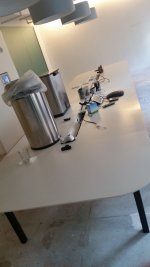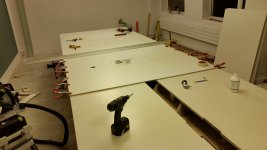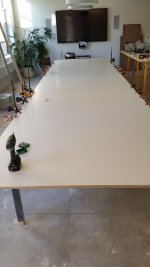ear3
Member
- Joined
- Jul 24, 2014
- Messages
- 4,341
I have another question about a table resurfacing project I'm starting next week, which relates to adhesives.
I'm resurfacing the tables pictured below, which have a Baltic Birch top with spray lacquer finish, with a Melamine coated sheet of veneer core plywood known as Colorfin (melamine coating is on both sides):
[attachthumb=1]
The Colorfin sheets will be secured to the existing top with screws from the bottom of the table -- but I also wanted to glue down the edges so there are no visible gaps between the old top and the new.
So I'm wondering, what would be a good adhesive to use for this -- again, something I would only apply to the edges rather than the whole panel, which would not be responsible for securing the panel but simply to keep the edges together. I want something that would dry relatively quickly, as well as something that would not expand/squirt out onto the edge itself. I think I read somewhere that you can mix superglue with other types of adhesives to get the materials to set quickly while the other glue does its work. Is this also an option?
Thanks for any suggestions.
I'm resurfacing the tables pictured below, which have a Baltic Birch top with spray lacquer finish, with a Melamine coated sheet of veneer core plywood known as Colorfin (melamine coating is on both sides):
[attachthumb=1]
The Colorfin sheets will be secured to the existing top with screws from the bottom of the table -- but I also wanted to glue down the edges so there are no visible gaps between the old top and the new.
So I'm wondering, what would be a good adhesive to use for this -- again, something I would only apply to the edges rather than the whole panel, which would not be responsible for securing the panel but simply to keep the edges together. I want something that would dry relatively quickly, as well as something that would not expand/squirt out onto the edge itself. I think I read somewhere that you can mix superglue with other types of adhesives to get the materials to set quickly while the other glue does its work. Is this also an option?
Thanks for any suggestions.



